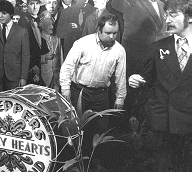Sixties
City presents
a wide-ranging series of
articles on all aspects of the Sixties, penned by the creator of the iconic
60s music paper Mersey
Beat
|
Sixties
City presents
a wide-ranging series of
articles on all aspects of the Sixties, penned by the creator of the iconic
60s music paper Mersey
Beat
|
|||||
|
   |
The
British artist Peter Blake was born in Dartford, Kent on 25th June 1932
and, like David Hockney, came to prominence in the Sixties with his paintings
capturing some of the flavour of the times. Blake taught at St. Martin’s School of Art, Harrow School of Art and Walthamstow School of Art between 1960 and 1964 and was featured in Ken Russell’s ‘Monitor’ programme ‘Pop Goes The Easel’ in 1961. In 1962 he had a one-man exhibition at the Portal Gallery and the following year married the sculptor Jann Haworth. He began teaching at the Royal College of Art in 1964 and had a further one-man exhibition at the Robert Fraser Gallery the following year. |
 |
It was in 1967 that he designed the famous ‘Sergeant Pepper’s Lonely Hearts Club Band’ album sleeve with his wife. See 'Sergeant Pepper' page for further information Blake also produced paintings of various rock artists, including The Beatles. One of his most famous Sixties productions was ‘Babe Rainbow’ a cryla and collage on hardboard, which he produced in 1967. Dodo Designs commissioned the plaque of this fictitious female wrestler who he depicted in a skimpy costume, her flesh glistening with body oil. 10,000 copies were silk screened onto tin and sold at £1 each. Blake wrote a biography for his creation: “Babe Rainbow, a fictitious lady wrestler, is the most recent in the line of wrestlers I have painted. These include Irish Lord X, Doktor K. Tortur, Kamikaze and Les Orchidees Noires. She is twenty-three years old and has broken her nose in the ring. She was born in New Cross, London, and wrestles mainly in Europe and the USA as there have only been a few contests between lady wrestlers in London. She is the daughter of the notorious Doktor K. Tortur". Blake continued to enjoy the fruits of his success and a retrospective exhibition of his work was held at the Tate Gallery in 1983, the year he received a CBE. He also designed the official poster for Live Aid in 1985 and was the subject of a ‘South Bank’ television documentary in November 2006. SC: There is actually comparatively little material output from Blake in the 1960s. "I look back with surprise that I did so few prints in the early days," he says. "I think in the Sixties, when most of my contemporaries were making a lot of prints, like Hockney and Kitaj, on some kind of odd principle I didn't make any. It was a curious kind of moral stand, something to do with commercialism and just making things to be sold, whereas now I'm much happier to embrace all of that". |
||
|
Article
Text
UK
web hosting by
|